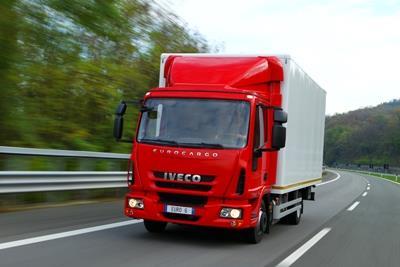
The first Euro-6 Iveco Eurocargo middleweight trucks will appear on UK roads in the next month or so. No matter what their load, they will also be carrying a good deal of responsibility for Iveco’s fortunes. Eurocargo accounts for over half of all the trucks (6-tonne GVW or more) Iveco sells in the UK, so the model is central to the brand’s
success here.
At November’s launch of the Euro-6 model in London, Iveco UK and Ireland MD Claudio Zanframundo said that in the UK, Eurocargo “continues to be acknowledged as the benchmark in medium trucks”. In 2002, Eurocargo certainly was a real force to be reckoned with, accounting for almost one in four of new trucks from 7.5-tonne to 18-tonne GVW registered in the UK that year. By 2012, Eurocargo’s share had fallen to 10.9%, although it picked up to 12.7% in 2013.
This decline in Eurocargo’s market share coincides with the rise of the Japanese challenge at 7.5-tonne GVW. In 2002, Eurocargo held an impressive 32% of the UK’s 7.5-tonne GVW market, while Japanese marques had just 6%. By 2013, the Japanese share – Isuzu, Fuso and Hino – had quadrupled to 22% while Eurocargo’s had dropped to 17%. But such a sharp decline was not necessarily inevitable. Daf’s share of this sector rose from 27% to a dominant 39% during this time.
Aside from market share, Eurocargo has had to contend with the fact that the 7.5-tonne market has shrunk radically since 2002. Compounding these two trends meant that the number of new 7.5-tonne Eurocargos entering service fell from 4,000 in 2002 to just 1,300 in 2013.
The second most important weight sector in the UK middleweight truck market is from 15-tonne to 18-tonne GVW. This is traditionally one of the most stable of all sectors, but Iveco’s share has halved, from 12.7% in 2002 to 6.1% in 2013.
Upside
Is the Euro-6 version capable of reversing that trend? On the upside, Iveco has at last chosen to increase the swept volume of its Tector engines. At 3.9 litres for the 4-cylinder and 5.9 litres for the 6-cylinder, these were below the average for the 7.5-tonne and 18-tonne sectors respectively, so the increase to 4.5 litres and 6.7 litres brings them more into line with the market. This gives a welcome boost in torque to the crucial 160hp rating of the 4-cylinder engine, sure to be the most popular in the 7.5-tonne Eurocargo. It can now square up to the 150hp Daf LF45.
At the other key weight, 18-tonne GVW, where 250hp has been the core rating for Iveco in the past,
Euro-6’s 250hp six-cylinder Tector is no better than Euro-5’s in terms of torque output, so its
peak torque plateau is 100Nm below that of the 250hp 6-cylinder Cummins/Paccar engine in the market-leading 18-tonne Daf LF. Daf has also given its LF range a minor facelift, whereas it may well be another year or two before Euro-6 Eurocargo gets a Stralis-style make-over.
However, Eurocargo gets a big tick in an important box, namely unladen weight. Iveco’s clever SCR-only Euro-6 NOx reduction strategy is lighter than rivals’ EGR plus SCR approach, so the additional weight on the Eurocargo is only about 70kg according to Iveco, about half of that of most others. Fuel consumption at Euro-6 is claimed to be broadly the same as at Euro-5, although 2% better on the motorway in particular.
Automatic option
Iveco’s decision to offer the option of ZF’s 12-speed AS-Tronic automatic box in Eurocargos from 12-tonne GVW and above with the 6-cylinder Tector is intriguing. Until now, only MAN has paired a 12-speed automated box with trucks this light. For Euro-6 both Volvo and sister company Renault Trucks are also introducing a 12-speed automated box (I-Shift/Optidriver) as an option at 18 tonnes – but no lighter – so it will be interesting to see if multi-speed automated boxes will gain real traction in this sector of the market.
The registration figures show Daf is the real benchmark in the UK middleweight sector these days. Of the other contenders, we single out Mercedes-Benz as the one to watch at Euro-6. It has all-new 4- and 6-cylinder engines, a new cab at 18 tonnes (Antos/Actros) and a reworked cab for Atego at 16 tonnes and below. Both also have the option of the Mercedes 8-speed Powershift automated gearbox. Fuel consumption is believed to be up to 5% better than Euro-5 equivalents, but will Atego be light enough to make a decent fist at 12-tonne GVW and below?
Volvo and Renault also have new, larger 4- and 6-cylinder engines with more torque to re-invigorate their challenge between 12 tonnes and 18 tonnes for Euro-6. And will Japanese manufacturers crank up their market share at 7.5-tonne GVW, with Renault set to join them in 2015 with a lightweight D range model co-developed with Nissan?














